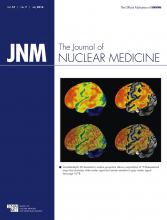Treatment options for patients with metastatic castration-resistant prostate cancer are limited, consisting of chemotherapy with taxanes or hormonal therapy with abiraterone or enzalutamide (1). These treatments result in a survival benefit of several months.
Prostate cancer cells, including castration-resistant prostate cancer cells, may overexpress prostate-specific membrane antigen (PSMA). Therefore, compounds that target PSMA were developed early on for diagnostic imaging and later also for delivery of internal radiation to tumor sites. For diagnostics 68Ga-labeled PSMA ligands are often used, and for treatment 177Lu-labeled agents can be used. This approach, using the same compound (or a very similar one) for both diagnostic imaging and therapy, is referred to as theranostics. The only difference between the diagnostic compound and the therapeutic agent is the radionuclide used. The principle of theranostics has a history in nuclear medicine dating back to the application of 123I/131I in thyroid disease and, more recently, to somatostatin receptor imaging and therapy with [111In-DTPA]octreotide
See page 1006
and [177Lu-DOTA,Tyr3]octreotate (177Lu-octreotate), respectively. Peptide receptor radionuclide therapy (PRRT) with 177Lu-octreotate proved valuable in patients with metastatic neuroendocrine tumors (2), and a recent randomized controlled trial demonstrated a significant gain in progression-free survival for patients treated with PRRT compared with the control patients treated with high-dose somatostatin analogs (progression-free survival not reached vs. 8 mo, respectively; hazard ratio, 0.2; expected progression-free survival for the PRRT arm, ∼40 mo) (3). For this reason, such an approach may also be promising for prostate cancer patients.
In this issue of The Journal of Nuclear Medicine, Baum et al. report on the toxicity and efficacy of treatment with a 177Lu-PSMA ligand, 177Lu-DOTAGA-(I-y)fk(Sub-KuE), in patients with castration-resistant prostate cancer (4). 177Lu-PSMA showed high, specific, and rapid uptake in prostate cancer metastases. The long effective half-life in both skeletal and soft-tissue metastases, approaching the physical half-life of 177Lu, resulted in a high mean absorbed dose in both bone and lymph node metastases. As for toxicity, only mild and transient xerostomia occurred, because of the radiation dose to the salivary glands. More importantly, no significant hematologic toxicity occurred. A 2005 study on radioimmunotherapy using the PSMA antibody 177Lu-DOTA-J591 was limited by myelosuppression in addition to nonhematologic toxicity (5). In the patients studied by Baum et al., the serum tumor marker prostate-specific antigen decreased by more than 50% in 62% of patients. With CT, a partial remission was found in 20% of patients, and when evaluated with 68Ga-PSMA, partial remission was observed in 56% of patients. The discrepancy in the evaluation of remission in patients classified as responders by 68Ga-PSMA PET/CT but not by stand-alone CT can be explained by the lower sensitivity of stand-alone CT in the assessment of skeletal lesions. An impressive median progression-free survival of 14 mo was found.
Other groups, using 177Lu-DOTAGA-(I-y)fk(Sub-KuE) (also termed 177Lu-PSMA I&T) or other radiolabeled PSMA ligands, have also reported promising results for patients with castration-resistant prostate cancer, albeit in small patient groups (6–8). In particular, a study by Ahmadzadehfar et al. (8), using 177Lu-DKFZ-617 PSMA, had results similar to those reported by Baum et al. Ahmadzadehfar et al. retrospectively analyzed the early side effects and response rate in 10 patients. Eight weeks after the therapy, 5 patients (50%) had a prostate-specific antigen decline of more than 50%. No patient experienced any side effect immediately after injection of 177Lu-PSMA. Grade 3 or 4 hematotoxicity occurred 7 wk after the administration in one patient.
The data reported by Baum et al. were obtained from patients who were treated under conditions of compassionate use, implying that a control group was lacking. Because of the encouraging results found by Baum et al. for 177Lu-PSMA treatment, it seems mandatory that this therapy obtain its recognized place in the treatment algorithm for metastatic prostate cancer. This status can be achieved only through randomized controlled trials. After all, alternative treatments have been tested in this way as well, and authorities and treating physicians will ask for such proof. Also, in many countries reimbursement is restricted to the use of registered pharmaceuticals.
For decades, it has been customary in nuclear medicine to use diagnostic and therapeutic radioactive compounds that are synthesized locally in house. For instance, PRRT for neuroendocrine tumor patients is performed using several different somatostatin analogs radiolabeled with different radionuclides. Also, the dosing scheme and dosing interval vary from institution to institution.
To get the recognition it deserves, radionuclide therapy such as that with 177Lu-PSMA needs to become standardized and tested in randomized trials, as occurred with 177Lu-octreotate PRRT in the NETTER-1 trial (3). Achieving this goal implies the involvement of radiopharmaceutical companies as manufacturers and sponsors. This is the only way in which radionuclide therapy can establish its role and come to maturity. One may therefore hope that we will soon witness the start of randomized controlled trials of 177Lu-PSMA ligands in prostate cancer patients. One may also expect that radionuclide therapies will be developed for other types of cancer.
DISCLOSURE
No potential conflict of interest relevant to this article was reported.
Footnotes
Published online Feb. 18, 2016.
- © 2016 by the Society of Nuclear Medicine and Molecular Imaging, Inc.
REFERENCES
- Received for publication February 5, 2016.
- Accepted for publication February 8, 2016.







